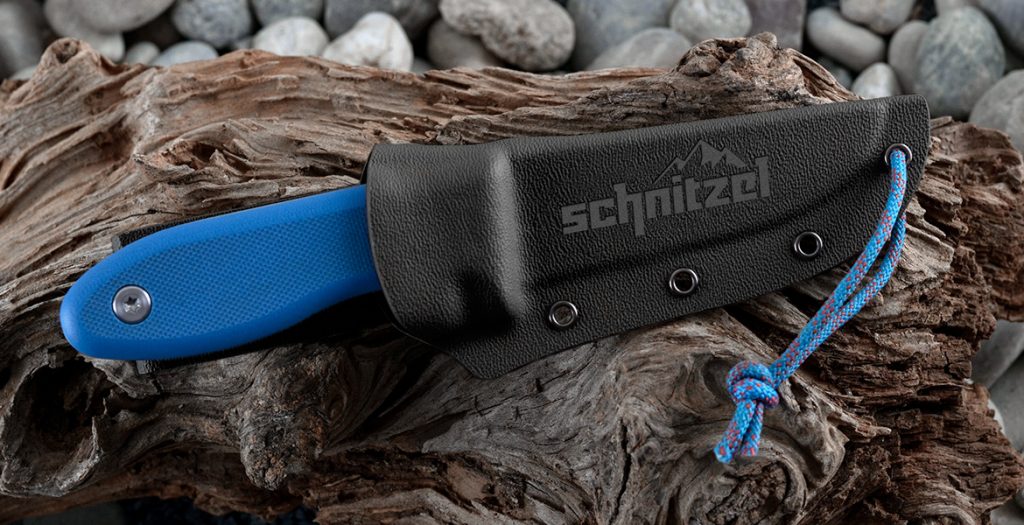The idea behind SCHNITZEL
Knives, especially children’s knives need to meet special requirements – in terms of safety, design and quality. That is why we have carefully considered and optimised each individual detail of our SCHNITZEL “UNU”. But what does that mean exactly? Our knife designer, Torben, is best at explaining it.
Torben, how long have you been interested in knives, in particular in knife design and knife making?
It all started back in 2012. I first got into it indirectly through my interest for watch design. The basic parameters, such as proportions, geometry, materials, mechanisms etc. are actually quite similar. Many watch fans therefore consider there to be a close connection with folding knives.
Each knife has its own shape and each knife manufacturer his particular signature lines which will appeal to some and leave others cold, depending on one’s own subjectivity. After having spent a long time looking for the perfect watch design that would exactly suit my personal taste, I then started my search for the perfect knife.
What draws you in particular to this topic?
The knife is the oldest tool in the history of mankind. Knives are there for a purpose and each should be adapted to be perfectly suited for its designated use. From peeling apples to batoning (i.e. splitting firewood) and everything in between, the possible applications are highly diverse.
Something I find particularly interesting is to look into which blade shape fits which purpose best, and which material should then be used. For example, a slim, narrow blade is useful for a knife designed for kitchen use, whereas more challenging outdoor works require a sturdier, more durable knife that is up to the job. Choosing the right blade steel for a knife is also absolutely crucial. There are purposes for which high carbon steel is better suited than stainless steel, and this applies the other way round too, of course. Powder metallurgy steels are now increasingly being used, too. These can be unbelievably tough and durable and outshine older, more traditional knife steels in terms of their material properties.
What inspired you to design a knife for children?
I have two children myself, aged 5 and 8. We love to spend time outdoors, go hiking, and always take a whittling knife along. But I had some issues with the design and the execution of these children’s knives: On the one hand, the antiquated look, and on the other hand, the lack of stability.
In my opinion, knives for children need to be just as sturdy as knives for adults. The same applies to the materials, as children usually do not take care of a knife in the same way as grownups do. They are much more carefree and that is exactly what the SCHNITZEL is designed for. My goal is to develop something modern that appeals to me and is in no way inferior to knives for adults – neither in terms of shape, design, handling, and definitely nor in terms of quality.

Tell us more about your designing process for the SCHNITZEL project.
It all started with the idea of developing a modern, sturdy, functional and simple outdoor knife for children. After various sketches, the idea turned into a graphic representation that, then again, had to be turned into a reality. With the help of a friend, we transferred the sketches into a CAD software and then tweaked and fine-tuned the shapes to create a real-size, 3D-printed model. That was incredibly helpful in terms of getting a feel for the knife. Some more small modifications were made afterwards to keep the SCHNITZEL as simple and sturdy as possible without compromising on the design.
Which aspects were particularly important to you in terms of the design?
When it comes to using knives, the children’s safety is of paramount importance. In order to guarantee safety at all times, various requirements must be fulfilled.
Top of the list was choosing the ideal handle material. It needed to be sturdy and skidproof for when children use the knife with wet / grubby hands or work with gloves. And as the knife would have to withstand extended exposure to dirt, heat, rain and cold without sustaining damage, I went for G-10. This material meets the requirements perfectly, which is why it is often also used for knives for adults.
The handle scales are secured with two stainless steel screws and are easy to remove for maintenance purposes. For enhanced safety, the handle is ergonomically shaped and features a finger guard to prevent the hand from slipping onto the blade.
In terms of size, the SCHNITZEL “UNU” has been optimised to be equally easy to handle by both younger and older children, so that they can start using it from a very young age and continue throughout childhood – almost until full growth. Over this period of time, children can get familiar with their knife at their own leisure and gradually learn to know and eventually love it. Even adults with larger hands can easily use it as a 3-finger knife, which makes it ideal for parents to show and teach their kids how to use it.
I purposefully opted for a somewhat thicker handle in order to help younger children achieve a better grip. As they don’t have such strong wrists yet and usually make more use of their arms to control the knife, they need a little bit more to „hold onto“, which also increases safety.
In order to allow for the best possible use in all age groups, I chose a no-nonsense blade shape design. Starting from the guard, the blade’s spine slightly dips away in a straight line, which lends additional strength to the thumb when carving. The ricasso is kept as short as possible, as the section of the blade where the most force can be applied for carving is right before the finger guard. The blade of the UNU has a long cutting edge that provides a lot of space for carving and then gently curves upward in a slight belly before terminating with a rounded tip.
The knife’s blade is fully flat ground in order to ensure the best possible cutting performance. The blade’s spine tapers from the ricasso to the tip without impairing the strength and stability of the knife’s point.
What else should we expect in the future?
We are already planning more knives for outdoor-loving kids. What’s more, at a later stage, we would love to develop a line of outdoor gear specially designed for children, for example rucksacks.
